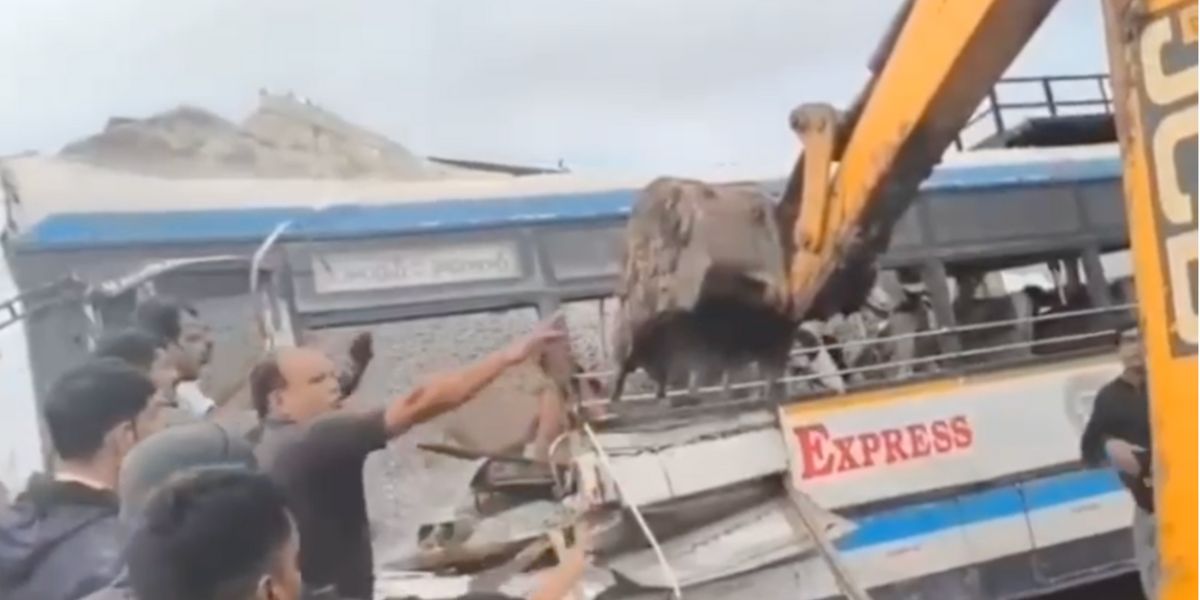The Tandur tragedy, caused by speed, is more than just a statistic — 20 lives erased before noon, each with a story unfinished.
Published Nov 03, 2025 | 1:00 PM ⚊ Updated Nov 03, 2025 | 2:09 PM

Rescue operation at the accident site in Hyderabad.
Synopsis: A TGSRTC bus collided head-on with a truck laden with crushed stones, claiming 20 lives, on the Tandur-Hyderabad highway. The bus was packed with office-goers, students, labourers, and families.
As the first light of dawn broke on Monday, 3 November, the usually busy Tandur–Hyderabad highway in the outskirts of Telangana capital Hyderabad turned into a scene of devastation — a corridor of twisted metal, shattered glass, and lost lives.
What began as an ordinary morning journey ended in catastrophe when a Telangana State Road Transport Corporation (TGSRTC) bus collided head-on with a truck laden with crushed stones, claiming 20 lives in an instant.
Amid the wreckage, one truth echoed louder than the sirens — speed kills. It didn’t just destroy vehicles; it ended the lives of the passengers and their dreams.
Among the survivors was a young boy, barely old enough to comprehend the chaos around him. Wedged in the rear seat, he had been travelling with his father to Hyderabad, where his mother was to be taken to a hospital.
The bus, packed with office-goers, students, labourers, and families, raced along the narrow highway. Moments later, the tragedy struck. A truck coming from the opposite direction, loaded with tonnes of crushed stone, rammed into the bus near Meerjaguda.
In that fatal second, the truck swerved violently — and ploughed into the front of the bus. The impact was devastating. Metal screeched against metal; glass exploded outward. The truck toppled, raining thousands of jagged stones on the bus like an avalanche, burying several passengers alive.
“The bus was flying,” the boy told reporters gathered at the scene. “Then there was a crash — and stones everywhere.”
His small voice, trembling with shock, carried the memory of those final moments — the cries that faded beneath the suffocating weight of rock and steel.
Three sisters returning to Hyderabad after a family wedding were also among those lost their lives.
What began as a happy family visit ended in unimaginable tragedy for the family from Tandur. The sisters Nandini, Saipriya, and Tanoosha, daughters of Ellayya Goud from Tandur, had gone home to attend a relative’s wedding. Nandini was in her first year of a degree course, Saipriya in her third year, and Tanoosha was pursuing an MBA — all studying in Hyderabad.
Police said the truck’s cargo worsened the tragedy; without the stones, many more might have survived.
Rescue teams and local villagers worked frantically with cutters and other tools to free those trapped. The drivers of both vehicles were found dead in their seats, their cabins crushed beyond recognition. Around them, survivors groaned in agony, waiting for ambulances that battled through the morning traffic.
By mid-morning, the once-busy highway had turned into a place of mourning. Families rushed to the site, their grief spilling over as the bodies were laid out in rows — faces covered, dreams extinguished. Mothers wept over shrouded forms; fathers stared in stunned disbelief.
As the sun climbed higher, in a nearby hospital, the young boy’s father was battling for life. The boy who does not know he has been almost orphaned stares into an uncertain future uncomprehendingly.
The Tandur tragedy, caused by speed, is more than just a statistic — 20 lives erased before noon, each with a story unfinished. For the boy who survived, the road to Hyderabad will forever carry the weight of loss and the memory of that terrible dawn.
(Edited by Muhammed Fazil.)
